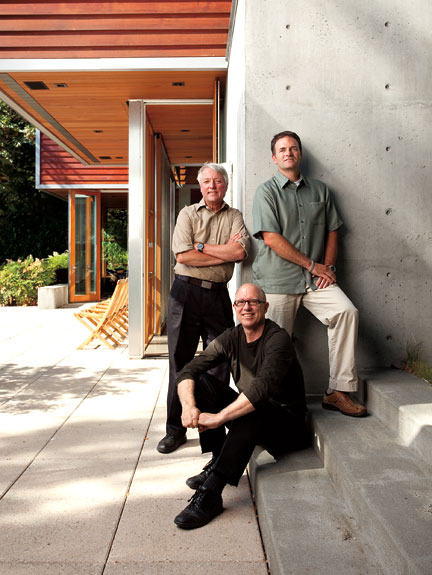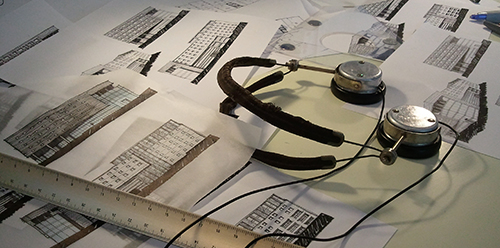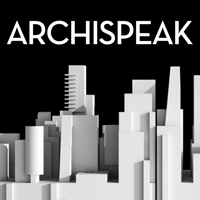Archive for the ‘Architects’Category
Lake Flato
I feel that one of the most imposing challenges that we face as contemporary designers and architects is the significance of regionalism in the design aesthetic. While we might all agree that a Bourbon Street simulacrum of an urban typology is not relevant when transplanted to Illinois, nor is an Adirondack lodge become office building appropriate in Texas, there can also be a

Ted Flato, FAIA
very fair argument that asks “why does your clean, unadorned minimalist Dutch modern design belong in my historic Georgia downtown?” The reality of regional styles is firmly imprinted in everyone’s minds, whether they realize it or not and new architecture is always compared and contrasted against the local vernacular.
Lake | Flato, a firm based in San Antonio, TX, has evolved an incredible architectural vocabulary that is both new and contemporary, while also utilizing relevant regional forms and materials in such a way that seems to address both sides of the debate. Their work is clearly “of” Texas, and their use of limestone, exposed metal and wood evoke very clear regional sentimentality while manifesting very contemporary design. While this may sound easy and logical, very few contemporary designers are doing this, and and even fewer as achieving the success and broad acceptance that Lake | Flato has. Read the rest of this entry →
01
12 2011
Louis Sullivan
 Louis Sullivan is a pillar in the history of architecture, and every student learns his name and takes a tour of his amazing breadth of architectural achievements. While one could refer to him as either the father of skyscrapers or the father of modernism, both would be correct. From his personal homes, to his banks to his skyscrapers, Sullivan forged a modern way of looking at design when western culture was drown in stylistic eclecticism.
Louis Sullivan is a pillar in the history of architecture, and every student learns his name and takes a tour of his amazing breadth of architectural achievements. While one could refer to him as either the father of skyscrapers or the father of modernism, both would be correct. From his personal homes, to his banks to his skyscrapers, Sullivan forged a modern way of looking at design when western culture was drown in stylistic eclecticism.
I’ve appreciated Sullivan’s work like I appreciated the paintings of the impressionist masters like Monet, Degas or Renoir who, to many a contemporary eye, produced works that feel more classical than revolutionary, because while they were breaking the academic rules of their art, they did it with seductively new techniques, and in a way that enhanced the experience. Sullivan’s architect does a very similar thing. With his skyscrapers, for instance, he respected the tripartite arrangement of “base-shaft-capital” fundamental to classical design, but applied it in to the typology in ways that enhanced the experience and allowed his architecture to evolve. Gothic flying buttresses make sense on a cathedral, they do not make sense atop a skyscraper. The brain reads patterns and appreciates being able to able to draw on know morphologies with new experiences, and Sullivan understood this. The rusticated bases of his skyscrapers gave a firm sense of grounding, the intermediate floors drew the eye up the height of the building, and the appropriately sized capital gave proper visual termination. These buildings felt new, were new, but manifest with an architectural coherency that belied their revolutionary reality. Read the rest of this entry →
01
11 2011
David Baker + Partners
 A small firm with a large impact on the residential scene, David Baker + Partners is an unabashed innovator in mixed-use urban infill and multi-family residential design. While their exposure is probably larger within the industry, particularly among those with associations to the typology, they consistently produce designs that are of the highest caliber.
A small firm with a large impact on the residential scene, David Baker + Partners is an unabashed innovator in mixed-use urban infill and multi-family residential design. While their exposure is probably larger within the industry, particularly among those with associations to the typology, they consistently produce designs that are of the highest caliber.
Located in San Fransisco, the firm benefits greatly from the tantalizing crucible in which the local vibe, urban culture and artistically sophisticated combine to produce a fertile ground for design opportunities. That said, being in this sector of design myself, many don’t understand the economic pressures placed on the typology, whose funding and financial returns are on completely difference scales than most commercial development, and how that, frankly, separates the innovative from the not. It’s easy to just give up and say “but the funding just isn’t there for that”, while it’s a quite a more challenging avenue to take these hurdles as a opportunities to foster new thinking. David Baker + Partners does this on a daily basis, constantly refining what urban living is, and can be. Read the rest of this entry →
01
10 2011
100 Architects | 100 Days – Miller Hull
 Miller Hull is a general practice firm which I’ve respected for quite some time. Just as I appreciate the sensitivity to regionalism that Lake Flato is famous for, so do I admire how Miller Hull used their Seattle roots to develop a design aesthetic that is very appropriate to the place. Often their materials are traditional, but their methods are innovative. Their forms are modern, but the emotions they evoke have a deep lineage in our culture. It is a subtle architecture that can push forward without alienating the past, and Miller Hull is excellent at it.
Miller Hull is a general practice firm which I’ve respected for quite some time. Just as I appreciate the sensitivity to regionalism that Lake Flato is famous for, so do I admire how Miller Hull used their Seattle roots to develop a design aesthetic that is very appropriate to the place. Often their materials are traditional, but their methods are innovative. Their forms are modern, but the emotions they evoke have a deep lineage in our culture. It is a subtle architecture that can push forward without alienating the past, and Miller Hull is excellent at it.
While the fundamentals of form are well executed by a great many designers, texture is such an incredibly important and overlooked aspect that is all too often not given it’s due. Material selection, placement, and execution can be very critical to communicate everything that a design intends. Miller Hull handles this expertly, and I encourage you to take a deep look into their body of work. Read the rest of this entry →
09
09 2011
MyArchitects – Walter Gropius
 For much of my collegiate career, Walter Gropius was a paragon of the architectural ideal. For me, he represented a blurring of the edges between architect, designer, teacher and philosopher that I personally found so immensely intriguing with the profession. As the catalyst behind the Bauhaus school, and certainly one of the fathers who gave birth to the morphology of modernism, Gropius’ work personifies everything that is elegant about contemporary design.
For much of my collegiate career, Walter Gropius was a paragon of the architectural ideal. For me, he represented a blurring of the edges between architect, designer, teacher and philosopher that I personally found so immensely intriguing with the profession. As the catalyst behind the Bauhaus school, and certainly one of the fathers who gave birth to the morphology of modernism, Gropius’ work personifies everything that is elegant about contemporary design.
While I had seen many of his works during and after the war, is wasn’t until I was introduced to his 1922 submission for the Chicago Tribune Tower Competition that whole new worlds opened for me. His entry, at a time less than a handful of years removed from the First World War, severed this association with the past (much as the war hearkened the end of the old world) not only incorporated his modern elegance, but suggesting a level of futuristic advancement few others, I believe, had begun to consider. Read the rest of this entry →
02
09 2011
MyArchitects
I’m going to be posting infrequent looks different architects who’ve inspired me. I’m at a point in my career that I’m rather quite happy with the opportunities that I’ve had, and am very comfortable where my design is going, and I thought such makes it an opportune time to reflect back on the architects who have influenced me. Possibly a self indulgence, the intention is for me to rigorously revisit the work of designers I hold in high esteem, and consider how their philosophies have become manifest in my own work. I also see it as an opportunity to critically consider my own design in deference to these masters, and work to elevate it to a higher level.
This list is not intended to be comprehensive, and is in no particular order. There will be many notable exception to this list who may very well appear on other lists of great architects, but for me, they are not whom I consider to have had significant impact on my thinking. This is also not intended to be simply a history lesson of notable designers and their works. Rather, I hope to achieve a more concise documentation of what, for me, has stood out about the work each have done. I hope this might possibly reveal designers to readers whom they’ve not come to know, or better yet, see designers in a light they may not have before. As always, I hope it sparks an open a vigorous discussion.






